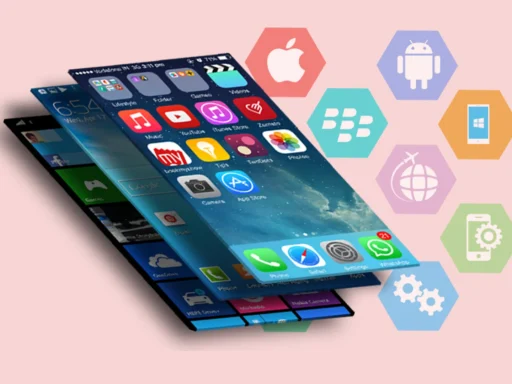The world of mobile games is wonderfully eye-opening and full of endless possibilities. From small, odd puzzle games to intricate RPGs, mobile games have become a source of entertainment omnipresent, knocking millions off the showcase. If you ever had this dream of creating your very own mobile game, this all-encompassing guide will take you through the necessary steps that will transform your idea from its infantile stage into a professionally polished app ready for the App Store.
Genesis of Your Game: Idea Becomes Concept
Start off with a spark of inspiration, a compelling idea that stirs your passion for game development. This could be a new gameplay mechanic, a fantastic narrative, or unique visual styles that breathe life into a game of its own. At any rate, something in a game development project is not inspirational enough; it needs to be fostered and developed into a concrete concept.
What, if any, of these genres are your game associated with? Puzzle game, action game, strategy game, or something novel? Once you do have a genre in mind, begin fleshing out the core mechanics of your game. What will the players be doing? How will they interact in that world? What kind of challenges will they overcome? Those are the building blocks that will shape the base of your game.
Understanding the Audience: The Basics of Mobile Game Development
A game in itself is not enough; one needs players to engage and experience its complexity, immersing themselves in its world. And that leads us to one very important aspect of mobile game development: the understanding of your target audience.
For what audience are you creating this game: casual gamers searching for quick nuggets of fun or hardcore gamers looking for a rich, immersive experience? Does it appeal to a specific age group, gender, or niche interest? All this and more depends on knowing your target audience and, therefore, drives everything from mechanics and art style to monetization strategy.
The Art of Crafting Winning Narratives: Storytelling in Games
Not every mobile game needs a complicated storyline, but a good story can make a huge difference in enriching the experience. Where games are purely playing games, and in them, a narrative may bring life to the story, giving a sense, motivation, and overarching purpose to work towards.
Consider how you might tell a story through the mechanics of your game. Does the gameplay itself tell a story? Do characters have individual personalities and motivations? Is the storyline branching off depending on a player’s choices? A good narrative, well-researched, can really draw players into your game world, creating an emotional investment that will drive them to keep coming back.
Key Influential Game Design Principles: Laying the Ground
With a clear concept and an understanding of your target audience, it is time to get into the technical aspects of mobile game development. This includes understanding the core principles of game design points that end up being crucial for creating a balanced, enjoyable, and engaging experience.
Game design’s core pillars are:
Gameplay is basically the standard mechanics and rules of your game, how to use the environment and their struggles. Gameplay must be intuitive, rewarding, and enjoyable in a way that encourages players to master its complexities and explore their world.
Level Design: A well-designed level can entirely redeem the game by challenging the players and encouraging the exploration of that level. Observe how the levels flow, where obstacles and rewards are placed, and what the general aesthetic is to provide a smooth experience to the player.
A good UI is that which provides the window between your game world and player. It must be intuitive, visually appealing, and understandable to allow smooth control of the action and interaction with all the features of the game.
User Experience (UX): This is the overall feel one would get from playing your game, from the onboarding process at the beginning to the tail end of it all. Make sure that the experience is smooth and intuitive, so that people are satisfied with being able to just keep coming back and play.
Prototyping Your Game: Ideas in Action
Now that you have a good idea and all the necessary tools, it’s time to create a prototype. A prototype is an in-and-out version of your game that lets you test how core mechanics and gameplay elements work without wasting much time on graphics or polish. It is one of the very important stages where the chances of finding issues and molding your ideas may arrive before releasing them into full-scale development.
Stay focused on the key features of what makes your game. Build a testable version that demonstrates core mechanics so you can get real-world feedback from multiple testers. Iteration is the heart of testing and refining, as this process informs you of which pieces are working and which ones aren’t, ultimately yielding a highly refined final product.
The Art of Mobile Game App Creation: Art and Layout
Visual design plays a significant role in mobile game development. The aesthetics of your game can attract players and enhance their overall experience. Consider the art style that best fits your game’s theme and target audience. Whether you opt for a minimalist design, vibrant colors, or realistic graphics, consistency is key.
The characters and environment as well as animations must all relate to the game’s story and mechanics. You can work with artists or utilize marketplaces of assets to suit your game’s context. Visuals have a lot to do with player engagement and retention.
Sound Design: The Experience Enhancer
Sound design, one of the most neglected aspects regarding the development of mobile games, is again very relevant. Audio encompasses background music, sound effects, and voiceovers, and can make your game even much more immersive.
This also considers the importance of sound in supplementing the gameplay. For example, sound effects can provide feedback on player actions, while background music can set the overall mood and atmosphere. It can be a great investment of your time in making your game more engaging and memorable for the players.
Testing and Quality Assurance: Polishing Your Game
The final stage of development sees all that can be done toward testing and quality assurance in full force. Bug hunting and fixing, silky smooth gameplay, and features that all work as expected are some of the mainstays of this process.
Any game mechanic, user interface, or how the game is actually running on varying devices is a must be tested. Taking part in beta test sessions could give you insights you may not be able to see in testing within your group. The final goal is to hand over a well-shaped product that will be satisfying players and create a seamless experience.
Mobile Game Monetization Strategies: Turning Passion into Profit
Once your game is ready for release, it is quite important to consider how you will monetize it. Mobile game monetization strategies differ considerably, and the best fits your target audience and the game design.
One of the most recognized free-to-play models is to allow the game to be downloaded and played for free yet charge in-app for more content or features. That tends to attract a better size of player base, but it requires very careful balancing to avoid frustrating paywalls.
The premium model can be a one-time charge for the game, which offers the player access to a full, separate experience without in-app purchases. This approach may appeal to those who prefer to make one straightforward transaction but it may limit your audience even further.
Subscription models are also a growing emphasis, where players have access to special content or features in exchange for a recurring fee. This can ensure subscription-based revenue, but requires constant updates with ongoing content to keep the user interested.
Creating Cross-Platform Games: Taking Your Reach Cross-Cutting Boundaries
In the modern world of gaming, it is increasingly essential for creating cross-platform games. Players now want to play their favorite games not only on their mobile but also on desktop and on their console.
You can reach a much wider audience and maximize the potential of your game by developing cross-platform games. Having game engines to support developing cross-platform games such as Unity or Unreal Engine will make things simpler. Think through how your game’s mechanics and user interface are going to accommodate different screen sizes and input methods, so that users get a comprehensive experience regardless of the platform.
Role of Mobile Game Development Company
For those who do not have the technical skills to develop a game on their own or don’t have the resources to do so, partnering with an iOS or android mobile game development company is perfect because these companies provide a form of game development service that covers creating ideas to deploying the final product while they use their expertise to bring your vision to life.
When selecting a company for your mobile game app creation, look for their portfolio experience and client reviews. A respectable company will have proven itself by delivering quality games with time and valuable insight throughout the development process.
Custom Mobile Game App Services Tailoring Your Game to Fit
Custom-made game app development services have become a popular choice for those seeking unique and tailored gaming experiences in the mobile game development world. These services allow developers to create games that closely align with specific client needs—whether it’s a business aiming to enhance brand presence or an individual looking for a personalized gaming experience.
Custom development allows the development of specific features, mechanics, and stories that are relevant to the end-user. This approach makes the game more appealing while at the same time creating a stronger relationship between the game and its players. With ever-growing demands for bespoke gaming experiences, custom mobile game app services will play a key role in the industry.
Inclusive Mobile Game Development: Carrying out Diversity
Overall, diversity in the gaming community calls for essential inclusive mobile game development. Developers increasingly realize that they need to create games that appeal to the widest possible audience with respect to backgrounds, abilities, and preferences.
The inclusive design would bring in elements like accessibility for disabled gamers, diverse characters, and relevant stories from different cultures. In this way, inclusions would make games accessible to a larger audience and strengthen the sense of belonging in the game. Belongingness and community are developed through inclusion; therefore, this strategy not only enhances the engagement level of the player but also fuels an exciting and diverse world of games.
The Role of Marketing: Learn How to Promote Your Game
Once your game is polished and ready for launch, the next step is to ensure it reaches its intended audience. Effective marketing strategies are crucial for generating buzz and attracting players to your game.
Start by creating a marketing plan that outlines your target audience, key messaging, and promotional channels. Utilize social media platforms, gaming forums, and influencer partnerships to spread the word about your game. Engaging with potential players through beta testing and community events can also help build excitement and anticipation.
It should come up with a great trailer that shows off all the cool and unique features, gameplay, and mechanics of your game. It will hook potential downloaders at a single glance. Optimization of an app store listing by adding proper keywords and striking visuals will also turn your game into a better discovery, fostering downloads.
Post-Launch Support: Keeping Players Engaged
Launching your game is just the beginning. For most of them, long-term success entails keeping your game updated and providing continuous support to customers. Active engagement with your player community through social media and in-game events is indeed a potent way to create loyalty and elicit return plays.
Game freshness and excitement require periodic updates with new content, new features, and improvements. In this aspect, paying heed to feedback from the players while alleviating their concerns will present an opportunity of giving them the value they expect and a quality product.
Performance Analysis: Learning from Data
After the game has gone live, it is very important to analyze performance in order to understand player behavior and possible potential improvements. Analyze your game using analytics tools monitoring metrics such as user engagement, retention rate, and monetization performance.
With this data, you’d have a better understanding of how the players interact with your game and therefore make the right decisions on where to improve features as well as the future updates.
Understanding player preferences and behavior helps in refining your game and improving the complete experience.
Conclusion: Your Journey as a Mobile Game App Developer
Coming on board in the mobile game development journey is a challenge and very rewarding at the same time. From the initial spark of inspiration to the final launch of your game, every step throws open possibilities for creativity, learning, and growth in turn.
Appnality is proud to be one of the leading mobile application development companies. We are here to transform your app ideas into reality. We are the best in the industry because of our expertise and commitment to excellence, thus converting your vision into a finished product ready for the App Store. Call us today, then, when you want to make your dream app come true. Let’s help you navigate the exciting world of mobile game development. Future prospects of mobile gaming look all the brighter, and you can be sure of receiving perfect upgraded content with Appnality.





